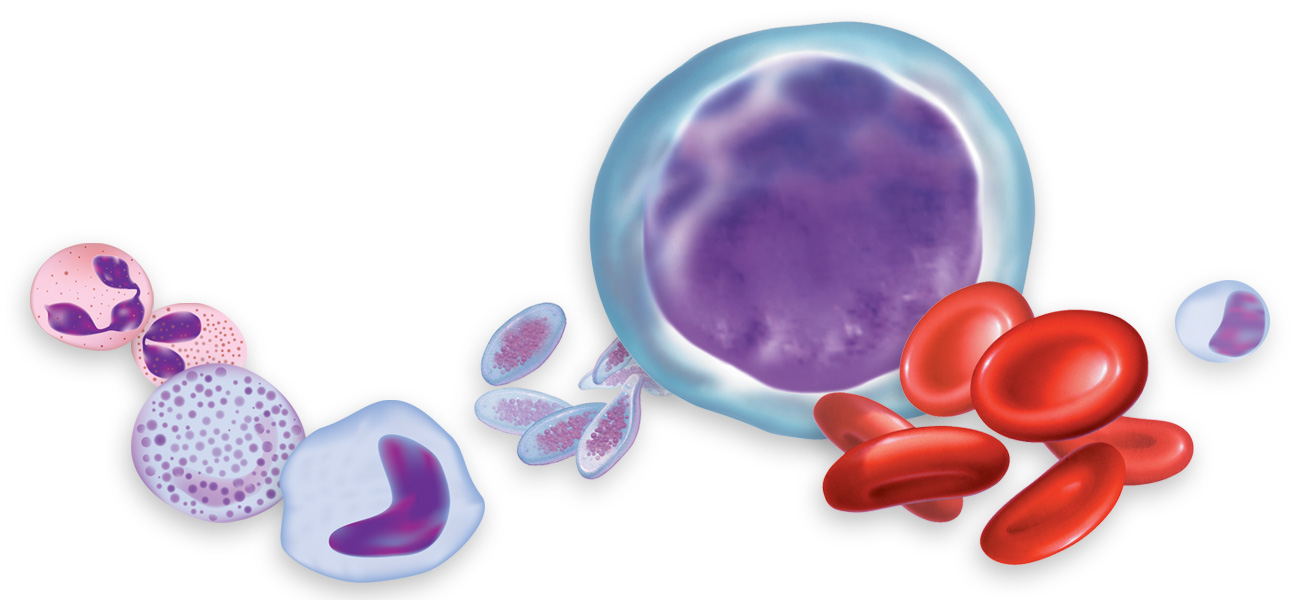Blood is the main transport system in the body. It is the liquid that flows through a person’s arteries and veins. It carries oxygen and nutrients to the lungs and tissue. It carries away waste products by taking them to the kidneys and liver, which clean the blood.
Our blood contains red cells, platelets and white cells suspended in plasma, the liquid part of our blood. Plasma is largely water with many chemicals also present, including:
- Proteins (such as erythropoietin, made in the kidneys, and albumin and blood-clotting proteins, made in the liver)
- Hormones (such as thyroid hormone and cortisol)
- Minerals (such as iron and magnesium)
- Vitamins (such as folate and vitamin B12)
- Electrolytes (such as calcium, potassium and sodium)
- Antibodies, which are made by plasma cells
Red Cells
Red cells make up a little less than half of the blood's volume. They're filled with the red-colored protein hemoglobin, which picks up oxygen in the lungs and delivers it to the cells around the body. Hemoglobin then picks up carbon dioxide from the body's cells and delivers it back to the lungs, where it's removed when we exhale.
Platelets
Platelets are small cells (one-tenth the size of red cells) that help stop bleeding at the site of an injury. For example, when a person has a cut, the vessels that carry blood are torn open. Platelets stick to the vessel's torn surface, clump together and plug up the bleeding site with the help of blood-clotting proteins such as fibrin and electrolytes such as calcium. Later, a firm clot forms. The vessel wall then heals at the clot site and returns to its normal state. Platelets also release growth factors that stimulate wound repair and new blood vessel formation.
White Cells
There are several varieties of white cells:
- Neutrophils and monocytes. These white cells are called "phagocytes" (eating cells) because they can ingest and kill bacteria or fungi. Unlike red cells and platelets, phagocytes can leave the blood and enter the tissues, where they can attack invading organisms and help combat infection.
- Eosinophils and basophils. These white cells respond to allergens or parasites.
- Lymphocytes. These white cells reside in the lymph nodes, the spleen and the lymphatic channels, but some enter the blood. There are three major types of lymphocytes: T lymphocytes (T cells), B lymphocytes (B cells) and natural killer (NK) cells. Each is a key part of the immune system.
Bone Marrow
Marrow is the spongy tissue in the central cavity of bones where blood cells develop. In newborns, all bones contain active marrow. By the time we reach young adulthood, the bones of our hands, feet, arms and legs no longer have functioning marrow. The spine (vertebrae), hip bones, shoulder bones, ribs, breastbone and skull contain the marrow that makes blood cells in adults. The process of blood cell formation is called hematopoiesis. A small group of cells — stem cells — develop into all the blood cells in the marrow, a process called differentiation.
Stem Cells
Healthy individuals have enough stem cells to keep producing new blood cells continuously. Blood passes through the marrow and picks up fully developed and functional red cells, white cells and platelets for circulation in the body.
Some stem cells also enter the blood and circulate. They're present in such small numbers that they can't be counted or identified by standard blood count tests. Their presence in the blood is important because they can be collected by a special technique and used for stem cell transplantation. Doctors use certain methods to induce more stem cells to leave their home in the marrow and circulate in the blood, allowing for greater stem cell collection. If enough stem cells are harvested from a compatible donor, they can be transplanted to the patient.
Stem cells also circulate, from marrow to blood and back, in a developing fetus. After birth, placental and umbilical cord blood can be collected, stored and used as a source of stem cells for transplantation.
